To race an Ironman triathlon, you have to be more than a little determined. And by determined, I mean crazy. Why? Because while an Olympic triathlon covers nearly 32 miles (.93-mile swim, 24.8-mile bike, 6.2-mile run) and is finished by top pros in roughly two hours, an Ironman triathlon covers over 140 miles (2.4-mile swim, 112-mile bike, 26.2-mile run) and is finished by top pros in at least eight hours. It’s not just regular crazy; it’s italicized crazy.
On the last Sunday in July, over 2,600 italicized crazy competitors descended on Lake Placid, NY for the 2010 Ironman Lake Placid triathlon, determined to spend up to seventeen hours conquering one of the more difficult U.S. Ironman triathlon courses outside of Hawaii. Oh, and did I mention that one of those italicized crazy competitors was my brother? Because one of the competitors was my brother, Luman.
Luman’s race day started bright and early: he left the hotel at 5:00am to be in town well in advance of the 7:00am start time. We spectators took up our positions by Mirror Lake and watched as the competitors entered the water and waited for the cannon. Unsurprisingly, the start line grew crowded with over 2,600 people in it.
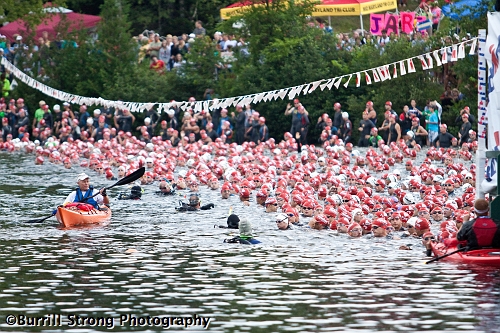
The kayaker and the scuba divers are there to help competitors who run into trouble. Support volunteers (with boats, kayaks and surf boards) were stationed all along the course, and scuba divers were stationed beneath the course.
The race started with a massive flurry of arms and legs churning the water.

Luman later recounted the violent chaos of the swim start, telling us he got kicked numerous times, once getting his goggles knocked off.
While the swimmers were all concentrating on navigating the course, we spectators were treated to the beautiful scenery surrounding Lake Placid.
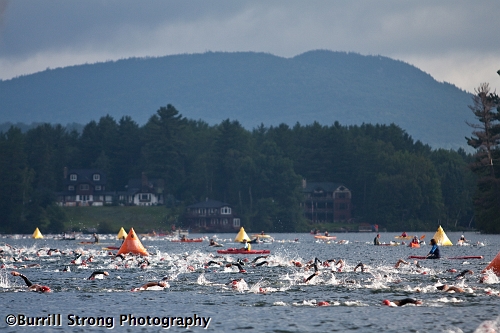
The dark clouds over the mountain weren’t empty threats: in the middle of the swim, it began to rain.

The rain was inconvenient for us spectators, but since the swimmers were in the water, it didn’t make much difference to them. It lasted only a few minutes, and but for one two brief light showers over the next hour or so, it remained dry and overcast the rest of the day.
As the swim photos show, there was no realistic way to spot Luman in the water; when you put wetsuits, swim caps and goggles on a crowd of men, they start to look the same. I stood at the swim finish for 45 minutes watching the swimmers finish their first lap, and I don’t know how many men I saw that I could have sworn were Luman. That means you’ll have to look at the swim photos above and pretend you can see Luman somewhere in the crowd.
The swim finish was crowded and chaotic, too, but since the competitors spread out a little bit over the course of the swim, it was chaos on a smaller scale.
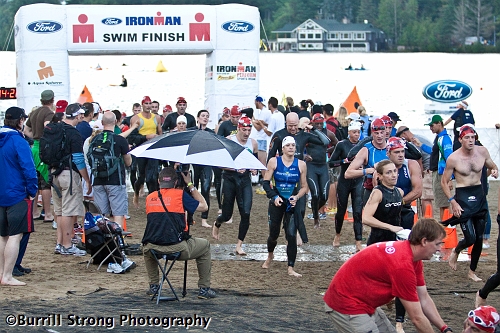
There was a bevy of volunteers stationed on the beach, and they all had one job: to help remove the competitors’ wetsuits. Though we couldn’t spot Luman in the water, we were fortunate enough to spot him on the beach.
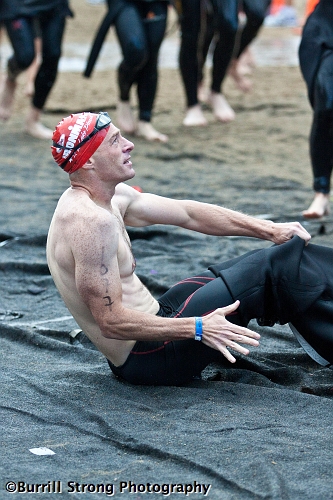


With his wetsuit removed, Luman began the quarter-mile run to the transition.

Luman finished the swim in 1:17:44 — nearly 20 minutes faster than he expected. It was a good start to his day.
On the path from the swim to the bike, one spectator had a curious note of encouragement for the competitors.
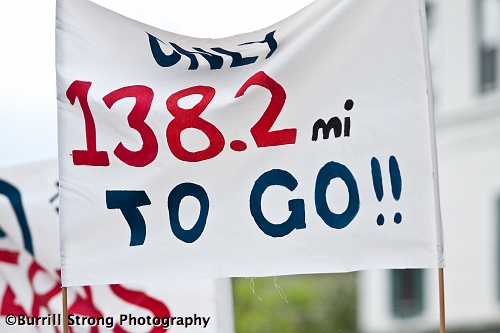
We weren’t able to make it to the bike start to see Luman, so we headed into town to enjoy the local Starbucks while we waited for him to finish his first lap. He thought his first bike lap would be about three hours, but since he rode more conservatively, it ended up being three and a half hours. We stationed ourselves in front of the 1980 Olympic arena in the middle of town to wait for him, and he greeted us happily as he passed.
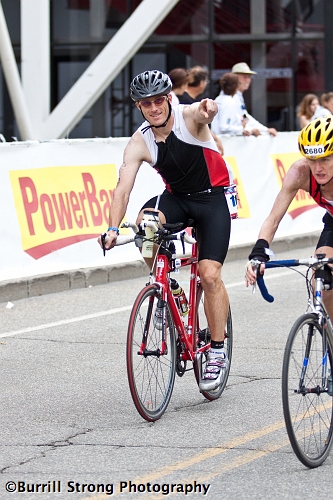

With Luman out for his second bike lap, it’s time for a brief tangent.
If the 1980 Lake Placid Olympic arena sounds familiar to you, there’s a good reason. It was the site of one of the greatest events in sports history: the Miracle on Ice. (If you’re not familiar with the Miracle on Ice, you should click the link and read about it.) The arena is open on race day, and while we were waiting for Luman to finish his second bike lap, we found an open door that let us onto one of the benches.

The arena is immaculately maintained and is still in regular use. It’s amazing to walk into the arena when it’s quiet and imagine the pandemonium back in February 1980, when the upstart U.S. hockey team upset the seemingly unstoppable Soviet team. For any sports fan with a sense of history, the Lake Placid arena should be on the must-visit list.

You may have noticed my shirt in the above photo. As explained in a previous post, that’s the shirt I designed as a way of showing support for Luman. We found the high-profile bright yellow shirts to be very useful: it was easy for us to spot each other, and it was easy for Luman to spot us. (The following photo is courtesy of my sister.)

Though he’s dressed for sleeping in the above photo, even baby Simeon donned the yellow!

With that tangent complete, we headed to the bike transition area to watch the end of Luman’s bike ride. While we were waiting, we were reminded that the Ironman is a brutal test for anyone; as one competitor rolled into the transition area, the volunteers immediately began calling for the medical staff. His day ended on the shoulders of two volunteers.

Luman entered the transition a few minutes later in much better shape.



Luman was consistent on the bike, keeping his second lap only a few minutes slower than his first; he finished the bike in 7:06:33. A few minutes later he was through the transition and on the run course.
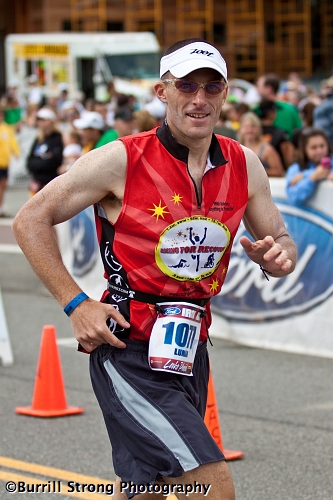
For spectators, the run is by far the easiest of the three events. It’s practically impossible to pick any one swimmer out of the crowd, and the bikes cruise by at a fast pace, but the runners lope by at a pace that makes it much easier to spot specific competitors. As well, because the course is two laps around an L-shape rather than a loop like the bike course, the corner of the L affords four chances to spot your competitors. That also makes it easy to spot the more extraordinary competitors, like this remarkably determined gentleman.

Though the race was (understandably!) beginning to wear on Luman, he still had a smile and a wave whenever he passed us.


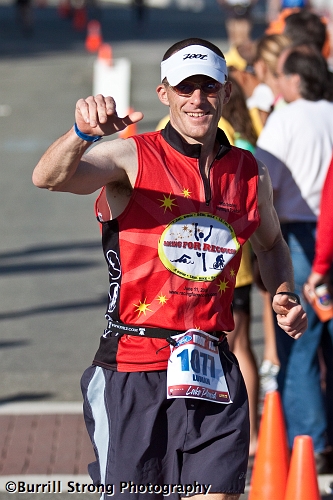
As Luman began his second lap of the run, we headed to the finish line to wait for him. While we waited, we were thoroughly entertained by the steady stream of overjoyed competitors crossing the finish line. Seriously: the finish line of an Ironman is one of the happiest places on earth. Some finishers danced their way to the finish line, one even did a cartwheel, and even the finishers who clearly had just enough to reach the finish line still had a look of pure happiness on their faces.
After a couple hours — shortly after the sun set — we saw Luman enter the final stretch. He was weary, but like the other finishers, he was happy.

Going into the race, Luman’s goal was to finish in 14 hours. He finished the run in 5:23:43, and he crossed the finish line at 14:08:57.

Though he’d just finished 14 hours of non-stop exertion, he had no trouble walking back to the van. And though we all expected him to be out of commission the next day, he was limber enough to join us on our visit to the top of Whiteface Mountain. In fact, while he admitted to being a bit sore, he seemed to be more spry than some of us spectators — an accomplishment he attributed to his rigorous training.
Before the trip to Lake Placid, Luman’s wife had arranged for a surprise: an artistic friend was going to paint the Chelsea rock to celebrate Luman’s successful race. We arrived home Tuesday night, and by noon on Wednesday the rock was celebrating Luman’s accomplishment. A few minutes later, Luman arrived to find his surprise.
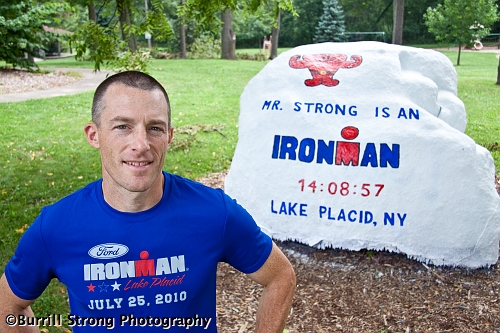
During the summer the rock often is painted once a day, but Mr. Strong’s Ironman rock remained unblemished from Wednesday noon through Monday evening.
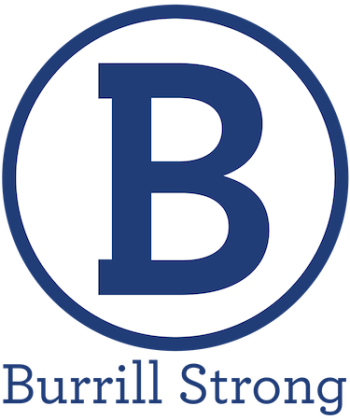
If you’re not familiar with the Miracle on Ice then you also must not have watched any of the Olympics for the last 30 years, since any significant upset is compared to that.
Wow, that might be the longest stretch the rock has stayed painted the same.
Awesome post, Boo. I loved the recap, since I was not there. I am so proud of our crazy brother! And also, really, really smart people take their honeymoon in Lake Placid.
Congrats Luman !! we are so proud of you !!!!! you will need to start training us : )
Alicia
FYI — “Olympic triathlon covers nearly 32 miles (.93-mile swim, 2.8-mile bike, 6.2-mile run)”. Typo? This doesn’t add up to 32 miles.
Oops! I left out the 4 in 24.8. It’s fixed now.
kauai vacations